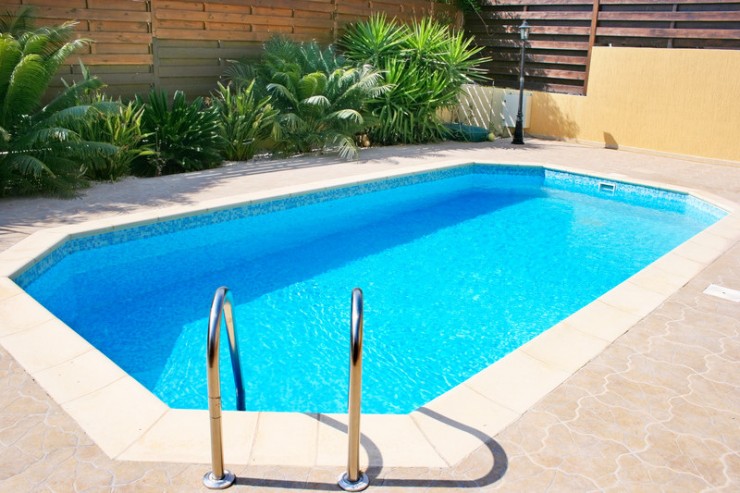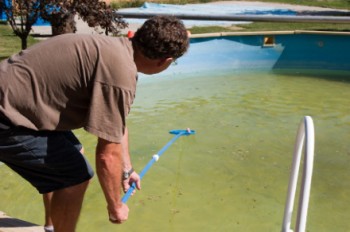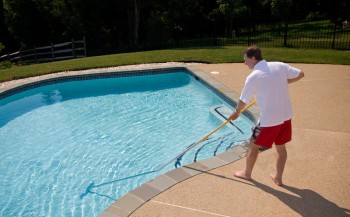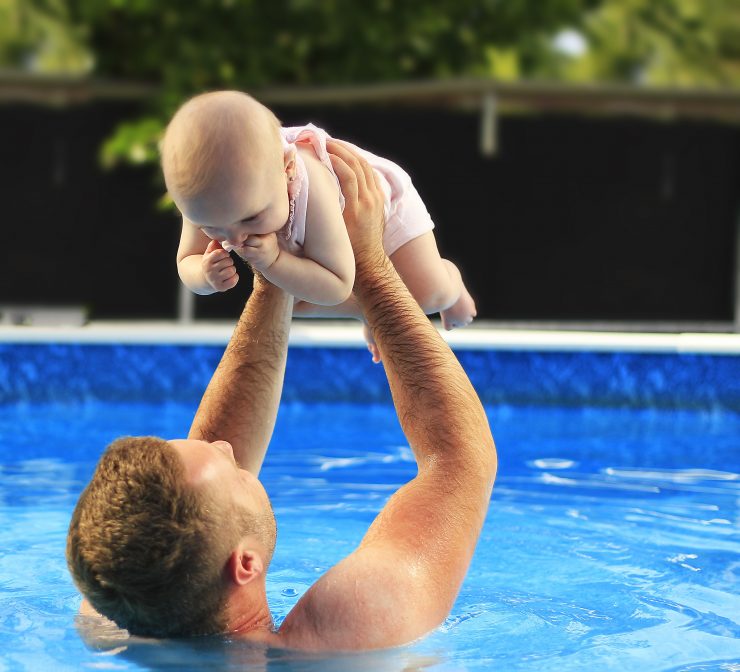
1. Skim Debris from the Pool Surface
And empty out your skimmer baskets at the same time. Don’t let the debris that gets sucked into the skimmers brew in there like tea that’s only going to be pumped back into your pool.
How often should you skim the pool and empty the skimmer baskets? If you don’t have a pool cover, once a day. If you do have a pool cover, then every 3 or 4 days will suffice.
I recommend this skimmer rake here.
2. Throw a Tennis Ball or Two into the Pool
This is an old pro trick that’s a cheap, effortless, and effective way to remove surface oils caused by suntan lotions, makeup, body and hair oils, etc. – all of which can lead to cloudy water and/or a depletion of your pool’s free chlorine levels.
What happens is that the oils get absorbed into the tennis balls’ fluffy surface. Therefore, newer tennis balls work better than older ones. Oh, and try not to chuck into the pool that tennis ball your dog’s been chewing on!
3. Clean the Pool Regularly
For plaster or concrete pools, use a stiff brush; for tiles, fiberglass, or vinyl, use a soft brush.
I recommend this brush and pole here.
Then vacuum the pool. If you have a manual vacuum, empty and clean the pump basket when you’re finished. And, if you have a sand filter, backwash and rinse.
This suction vacuum cleaner or this robotic cleaner will simiplfy your cleaning.
4. Test & Maintain the Pool Water Chemical Balance
During the summer, check and adjust the chemical balance twice a week. The best time for this is in the early evening after the last bather has left the pool. The ideal ranges are:
- pH 7.4-7.6
- Chlorine 1-3 ppm
The real pro cleaning tip is this: if you keep your pool water chemicals properly balanced, you won’t need to do as much cleaning.
You could try these Water Testing Strips or this Liquid Water Testing Kit.
5. Shock the Pool
Depending on how heavily your pool has been used, ammonia and nitrogen compounds will build up in the water. These interact with the chlorine to form chloramines – leading to cloudy water and/or that familiar smelly “chlorine” odour.
Shocking the water once a week by adding a large dose of chlorine eliminates not only the chloramines but also bacteria and other contaminants, and will help prevent potential future problems including algae growth.
Again, the best time to do this is at dusk, with your filter system running overnight. Why? Because chlorine is degraded by ultra-violet light (i.e. sunshine). It only takes a couple of hours of sunshine, if your stabilizer levels are too low, to destroy virtually an entire pool’s worth of chlorine. Adding chlorine at night means it can get to work without being degraded by ultra violet sunlight. What’s more, at night the chlorine is most useful – neutralising whatever’s been introduced to the water during an afternoon of swimming.
If you have a pool cover, you need to shock your pool less often: usually once every 10 days to weeks.
I recommend this Shock Treatment here.
You can read more in our article How To Shock A Swimming Pool For Beginners (In 8 Easy Steps).
6. Keep a Pumice Stone Handy
If the grout between your tiles, or the plaster or concrete liner of your pool, starts showing signs of algae growth that regular brushing won’t remove, give the infected area a rub with a pumice stone. The gentle yet abrasiveness of the pumice should be, at least in the early stages of algae growth, sufficient to break through the algae’s external protective layer without damaging the grouting/pool surface, and thereby allow your pool chemicals to get to work on destroying them.
7. Make Sure the Stabiliser Level is Correct
If your stabiliser level is wrong your chlorine isn’t going to be able to do its job, and your pool is going to have all sorts of problems.
As already mentioned, chlorine is degraded by sunlight. Pool stabiliser (cyanuric acid) slows down this process and increases the lifespan of the chlorine in your pool by anything between 5 and 10 times. However, the stabiliser level need to be maintained at 30-60 parts per million (ppm). Below that level, chlorine rapidly degrades. However, above that level there is no marginal benefit, and at anything above 100ppm, the stabiliser actually prevents the chlorine from sanitising the water.
I recommend this stabiliser here.
The practical upshot of all of which is: if your stabiliser level is in the correct range, you shouldn’t have problems that need cleaning up!
Recommended Products
Skimmer Rake – remove debris daily with a skimmer leaf rake.
Pool Net with Pole for skimming the leaves and debris from the pool surface.
Swimming Pool Brush for brushing down the sides of your pool.
Suction Vacuum Cleaner or Robotic Cleaner
Pool Water Testing Strips or Liquid Water Testing Kit
Would you like more pool cleaning tips? Read our article How to Clean a Pool: A Time Saving Guide.

Related Reading:
How to Get Rid of Swimming Pool Bugs that Swim
Could Your Swimming Pool Be Earning You Money?


Wow, I never would have thought of chucking in some clean tennis balls to absorb unwanted debris, I will for sure use this technique when cleaning my customers pools next time.
What do you do if your pool water is at 8.8 I don’t know what to put in to make it right …. Please help thank you and have a good day
Pool cleaning perhaps the most critical and important work schedule that every pool owner should aware of. Before you begin the pool cleaning, some of the common steps you can perform to make the pool condition lot better. Remove the debris and chemical as they can do lot of damage to the pool and see the water level. Skim the debris from the pool surface disallow the harmful debris to keep on existing in pool surface. Follow it up you can throw a tennis ball to remove surface oils caused by body and hair oil etc. Clean your pool at least once in a week to check that algae never spread in the pool surface. Algae cause the pool dirty and remember during the summer, check and adjust the chemical balance twice in a week. By doing all these important stuff your pool will be safe and hazard free. Great to know the probable pool cleaning tips which pool owner should follow up. Excellent blog to share.